NBC’s Hannibal: The Dichotomy of Elegance and Exploitation
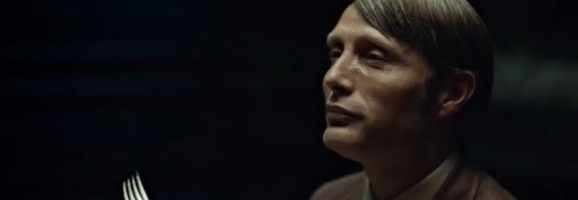
NBC’s Hannibal is a television adaptation of the infamous tale of Dr. Hannibal Lecter. For those of you who are unfamiliar with the titular character, he was first introduced in Red Dragon, a fictional novel written by Thomas Harris in 1981. Lecter is a brilliant psychiatrist but cannibalistic serial killer, whose legacy has spawned further novels and several film adaptations since his debut. Most famously Michael Mann’s Manhunter (1986) and Jonathan Demme’s The Silence of the Lambs (1991). Yet some arguably disappointing productions have also been produced, namely Ridley Scott’s Hannibal (2001), Brett Ratner’s Red Dragon (2002) and Peter Webber’s Hannibal Rising (2007).
Created by Bryan Fuller, this serial adaptation is based on the aforementioned novel, Red Dragon, allowing the show to surround Lecter at his prime, before his incarceration at the Baltimore State Hospital for the Criminally Insane. This origin approach to Lecter’s story allows for numerous possibilities with the show’s narrativisation, primarily his relationship with Will Graham, an FBI special investigator who shares an incredibly tumultuous friendship with the famed psychiatrist – one that eventually spirals into a case of worst enemies. One of Hannibal‘s greatest strengths in fact, is the development of both characters. It’s fascinating to see the two start off as strangers and engage in a close, personal friendship abound with chemistry and unsettling similarities, yet knowing the eventual demise that will occur. A greater delight however, is arguably the chance to view Lecter out in the real world – in the kitchen rather than behind prison cell bars. Audiences become accustom to his finesse, charm and upper class aesthete, his lifestyle of practicing psychiatry, fine dining and trips to the opera. As Dr. Bedelia du Maurier so exquisitely states, we come accustom to his life dressed in a very well tailored person suit. This sense of elegance however, doesn’t just stop at Lecter’s characterisation, it transcends into the show’s aesthetics.
Elegant Aesthete
Defined as ‘pleasingly graceful and stylish in appearance or manner’, the aesthetics in NBC’s Hannibal exude elegance. The show’s set design, especially surrounding Lecter, upholds an element of staging and performativity. His office is a neat mixture of antiquities and modernity, spatially articulating a classical sensibility. It boasts an element of grandeur as a means to impress, much like his kitchen (or should I say laboratory), that whilst retaining more modern qualities, is nevertheless streamline and stylish. His dining room presents itself as a stage or gallery, positing a centrally placed table bathed in spotlight, obviously as a means to showcase every piece de resistance Lecter produces.
Speaking of which, Lecter’s dishes embody elegance, thanks to the work of culinary consultant Chef Jose Andres. His mouth-watering delights are arguably stand alone works of art, an exhibition of stylised, gourmet food. Each dish is frequently fetishised, forever providing the complicated dichotomy of gluttonous appeal for shall we say… non-traditional ingredients. Other props or features used throughout the show exude a similar sense of lavishness, from the vast array of well tailored suits to the subtle inclusion of high quality, leather-bound furniture.
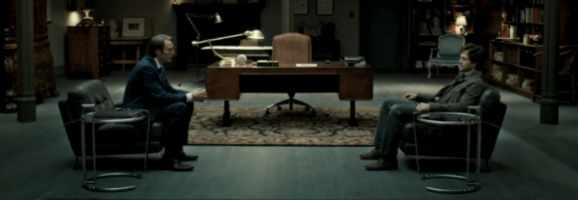
This upper class, bourgeois aesthete is then framed in an elegant, cinematographic way. With a beautiful combination of simple composition and accentuated lighting, highlighting texture and foregrounding silhouettes, each frame possesses a distinct painterly quality, exhibited through the use of simple editing. Whether it is a singular shot of Lecter in his office, or enjoying a feast at his dining table, the show’s aesthetics display it as a work of art, embodying class, beauty and grandeur. However this particular aesthete paradoxically surrounds the show’s exploitation, and herein lies the debate.
Exploitation
You would be perfectly in your right to scoff at the idea of Hannibal as exploitation. It lies as exponentially far away as possible from your Lucio Fulci’s and Herschel Gordon-Lewis’, the Grindhouse features of the 1980s and those seedy drive-ins. Furthermore, the show’s aforementioned elegant aesthete completely contrasts the defining feature of such a label – an aesthetic of grainy and primitive quality, often due to the productions low budget. This aesthetic provides a sense of realism, another defining feature of exploitation and one that Fuller himself as admitted to avoiding,
“If it’s too real it’s no fun for me. I’m very sensitive. The horror that we do on the show has a heightened quality to it and I kind of need that vibrating above reality-sense in order to enjoy the work, and have fun with it. If it’s too real, then it’s not as much fun”.
However thematically speaking, there is reason toward my Hannibal-exploitation pairing. Broadly speaking, although it is an almost undefinable term, exploitation can be applied to texts that “exploit” perceived immorality, showcasing crime, violence, sexuality, drug usage, nudity, torture and any other form of taboo. All of which, generally fall under sub-genres such as torture porn, rape revenge, splatter films and erotic horror. Furthermore, quoted in Eric Schaefer’s book entitled Bold! Daring! Shocking! True!: A History of Exploitation Films, 1919-1959 (1999), David F. Friedman defines the ‘classic’ exploitation as, “… any subject that was forbidden… as long as it was in bad taste!”
So, in addition to the grandeur that surrounds Hannibal, the very nature of the show’s crime scenes nevertheless class it as exploitation. Toy with this idea for a moment, if you will, by joining me on a brief analysis of a sequence, taken from episode eight entitled Fromage. Graham and Special Agent Jack Crawford enter a crime scene, introduced via a long shot, situated at a concert hall. The elegant location and use of spotlighting undoubtedly uphold the grandeur sensibility broached at the beginning of this study, now further emphasized by the stringed orchestral score. However, with a quick cut to a close up, the aforementioned ‘painterly quality’ transcends into shots showcasing each angle of a murder victim, rapidly edited together. He sits center stage under a spotlight, his body manipulated with a cello planted through his neck, exposing the vocal chords to act as string. After intermittent dialogue between both Graham and Crawford, Graham sinks into his empathetic mode with which he uses to piece together the serial killer’s motives. Whilst unraveling the killer’s design, Graham walks over to the body and proceeds to play the cello, depicted through an aerial shot.
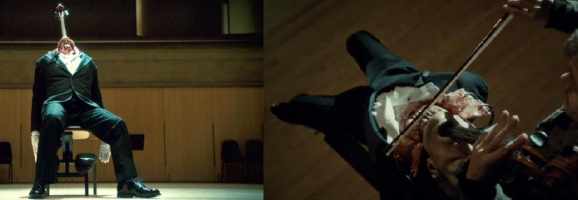
This sequence (encapsulated in the above images) without a doubt adheres to thematic definitions of exploitation. The human body is grotesquely manipulated, both by the killer and Will Graham, as he plays the instrument planted through the victim. In conjunction with each beautiful frame, the content is of bad taste and low moral quality. Furthermore it is exploiting the current trend of gory imagery in television horror, seen in other recent productions such as The Walking Dead and American Horror Story, adhering to the increasing desire of lurid subject matter on our screens. Clutching at straws? Perhaps, but I can’t help but feel that nearly all crime scenes which have featured throughout the first series of Hannibal also possess the same exploitative sensibility. In fact, some scenes are even arguably reminiscent of existing films firmly situated within the exploitation canon. For example, the Minnesota Shrike murders, which also appear throughout the first series, showcase the bare bodies of victims by mounting them on antlers, seen in the image below…
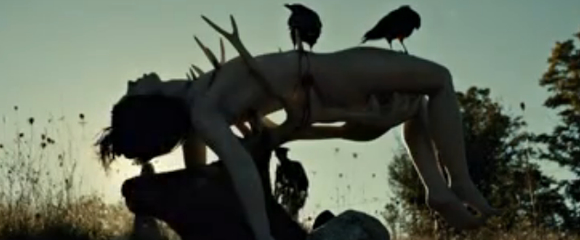
There is an undeniable similarity between this and the previous example, toward the notorious imagery of the impaled girl in the epochal exploitation film Cannibal Holocaust. Thus, one could argue it is the exhibitory nature of immorality that binds both Hannibal and exploitation together, amidst the un-traditional aesthetics of elegant cinematography, detracting from realism and framing each exploit in a paradoxically beautiful manner. So where does this leave the Elegance-Exploitation dichotomy?
Elegant Exploitation
Conclusively speaking, this very brief study has explored Hannibal’s elegant aesthetics polemical relationship with the show’s exploitative qualities. The upper class aesthete and beautiful cinematography paradoxically surround the shows violence and graphic imagery which more often than not culminate in weekly crime scenes. These crime scenes, some of which have been referred to throughout, demonstrate the show’s ability to fit under the broadly defined exploitation. The question is, can it really be both? The answer is yes it can. Exploitation purists may forever disagree however, I have hopefully demonstrated that elegance and exploitation, art and titillation can co-exist. Fuller has described the show’s unique framing of horrific and amoral imagery as ‘elegant horror’, but perhaps after this brief study, we could extend that and use the term ‘elegant exploitation’ instead.
What do you think? Leave a comment.
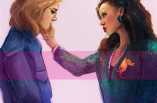
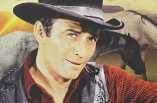
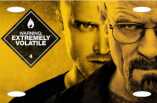
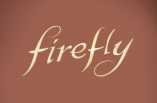


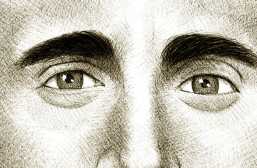


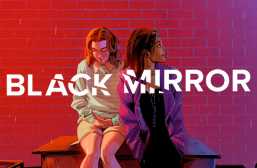
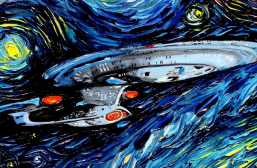
Think finally we can see the gray that exists between black and white… and it’s mysterious. Two characters equally opposed in almost mythological terms but also connected. My favorite TV show.
Really interesting essay we have here. While I’m not into slice and dice horror content, this series has been a pleasant surprise and I have to applaud NBC for airing it. Now let’s see if NBC can hold on to it’s integrity and let the writers continue to write it the way it was intended and not bow down to hurried ratings and change/speed it up/dumb it down the orig writing to appease the ones who don’t get it. If they do this in season two, it will fail.
Thank you! And I agree, but from interviews with Bryan Fuller it seems NBC are pretty much giving him free reign on a lot of things, so fingers crossed they have started as they mean to go on!
I can’t say that this is the kind of show that I’d enjoy, but great essay nonetheless! I’ve been reading a bit about the popularity of graphic violence in slasher films and Hannibal seems like a good place to take that discussion. Looking forward to more of your work!
Thank you! I’d definitely give Hannibal a go, especially if you’re discussing the popularity of graphic violence, lots of interesting ways to take the discussion and run with it!
Mads Mikkelsen is so dark, cunning and brilliant as Lecter. Nothing against Anthony Hopkins by no means, Hopkins portrayal as Hannibal was deliciously evil, but Mads has really gotten inside his character, and knows what makes him tick, what drives him to do what he does. I love the fact that you know every meal that he serves, is human, and his dinner guests have no clue.
Cheers for the thought candy, I will have this show in my mind all day now at work 😀
I may well be on my own here but I can’t help but prefer Mikkelsen’s take on Lecter?! May have something to do with the origin platform but nevertheless, he is as you say so dark, cunning and brilliant. I think in an interview somewhere either Fuller or Mikkelsen said they would approach the character/play him as Lucifer which I think is so spot on!
Interesting article, I dont mind horror but I find the murders too elaborate and far fetched to be taken seriously, I am saying this in context of the books written by Thomas Harris, TV show seems a cheap parody because there’s only cheap horror and non stop dramatic background music, they are trying really hard to create mood, it’s because they do not have a proper script. Real thing had intelligence of solving puzzles, real investigation and violence where it was needed.
Fair comments! I think comparing the novel to the TV series is a dodgy move though, especially in terms of fidelity. The two mediums are bound in totally different production/technological/cognitive factors that will have bearing on the adaptation.
Admittedly I haven’t seen the new series, but after having read your essay I can’t help but think of the films of Argento, with their beautifully crafted set-pieces and acid-trip aesthetics – the cello scene wouldn’t look at all out of place amongst his oeuvre.
This was a great piece to read. Bizarre that those once reviled Italian exploitation flicks (especially Cannibal Holocaust) have a stylistic legacy that has so thoroughly permeated the mainstream.
Totally agree! I have no doubt that Fuller, as a horror fan, would have at some point or another drawn some form of inspiration from the films of Argento – the similar aesthetic sensibility is most definitely there. It is bizarre that past exploitation flicks have integrated into mainstream horror – perhaps an interesting comment also on how audiences are becoming desensitized to all matters of horrific imagery?
Janice poon is the food stylist
Too
Engaging article! I’m a big Hannibal fan myself and you’ve just articulated what I think of whenever I see the show.